Branding and Diversification: A Study on the Virgin Group
VerifiedAdded on 2023/04/26
|29
|8072
|436
Report
AI Summary
This report provides a detailed analysis of the branding strategies employed by the Virgin Group, examining the role of brand equity in its business expansion and diversification efforts. The report begins with an executive summary, followed by an introduction that outlines the aims, objectives, and background of the study, including the research question and its potential significance. A comprehensive literature review explores the concept of branding, the role of brand equity, and various branding approaches used by organizations. A case study focusing on the Virgin Group is included. The research methodology section outlines the exploratory approach, interpretivism philosophy, and qualitative data collection through secondary sources, culminating in thematic analysis. The discussion chapter analyzes the findings, followed by conclusions and recommendations. The report aims to identify the significance of branding strategies in Virgin Group's success and suggest appropriate branding strategies for achieving a competitive advantage in the market.
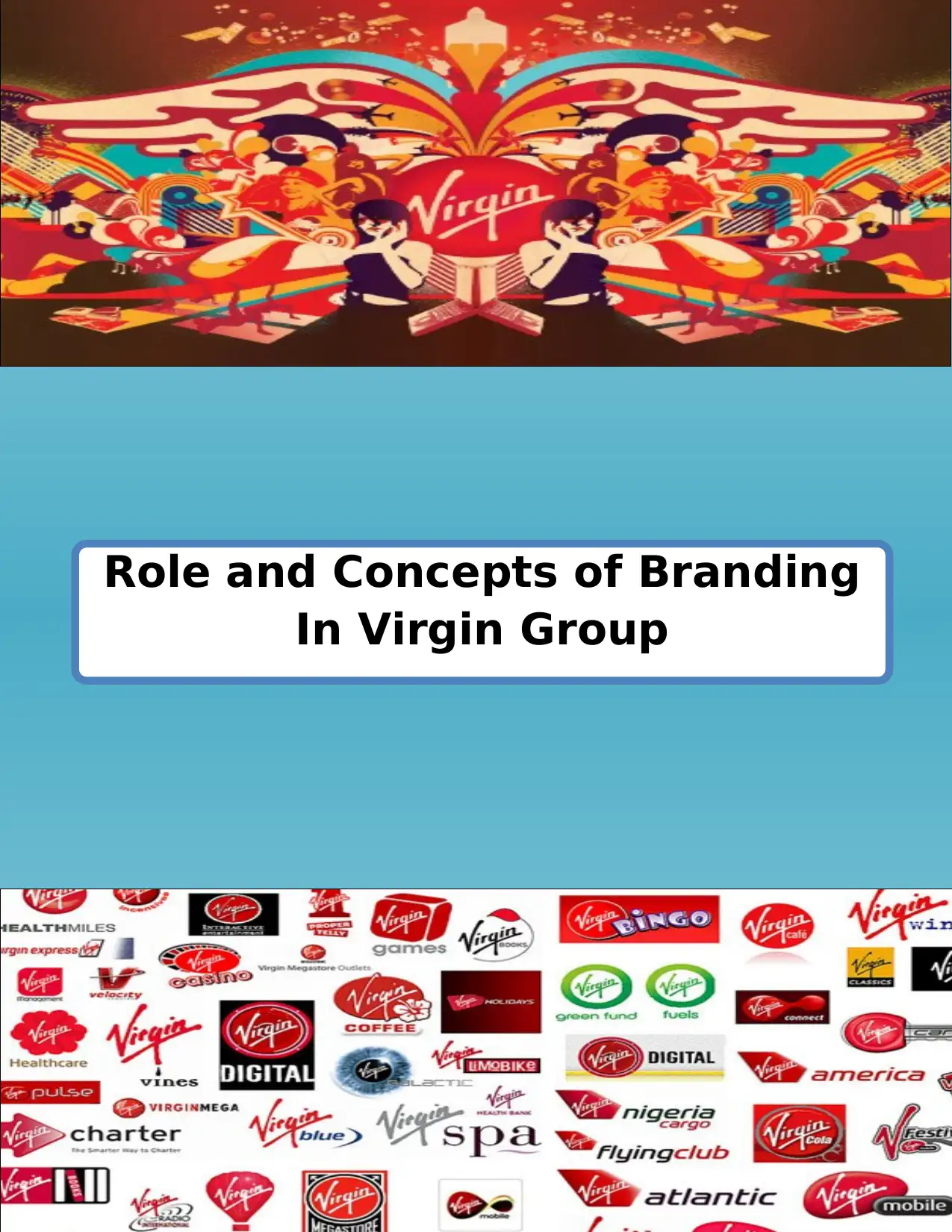
Role and Concepts of Branding
In Virgin Group
In Virgin Group
Paraphrase This Document
Need a fresh take? Get an instant paraphrase of this document with our AI Paraphraser
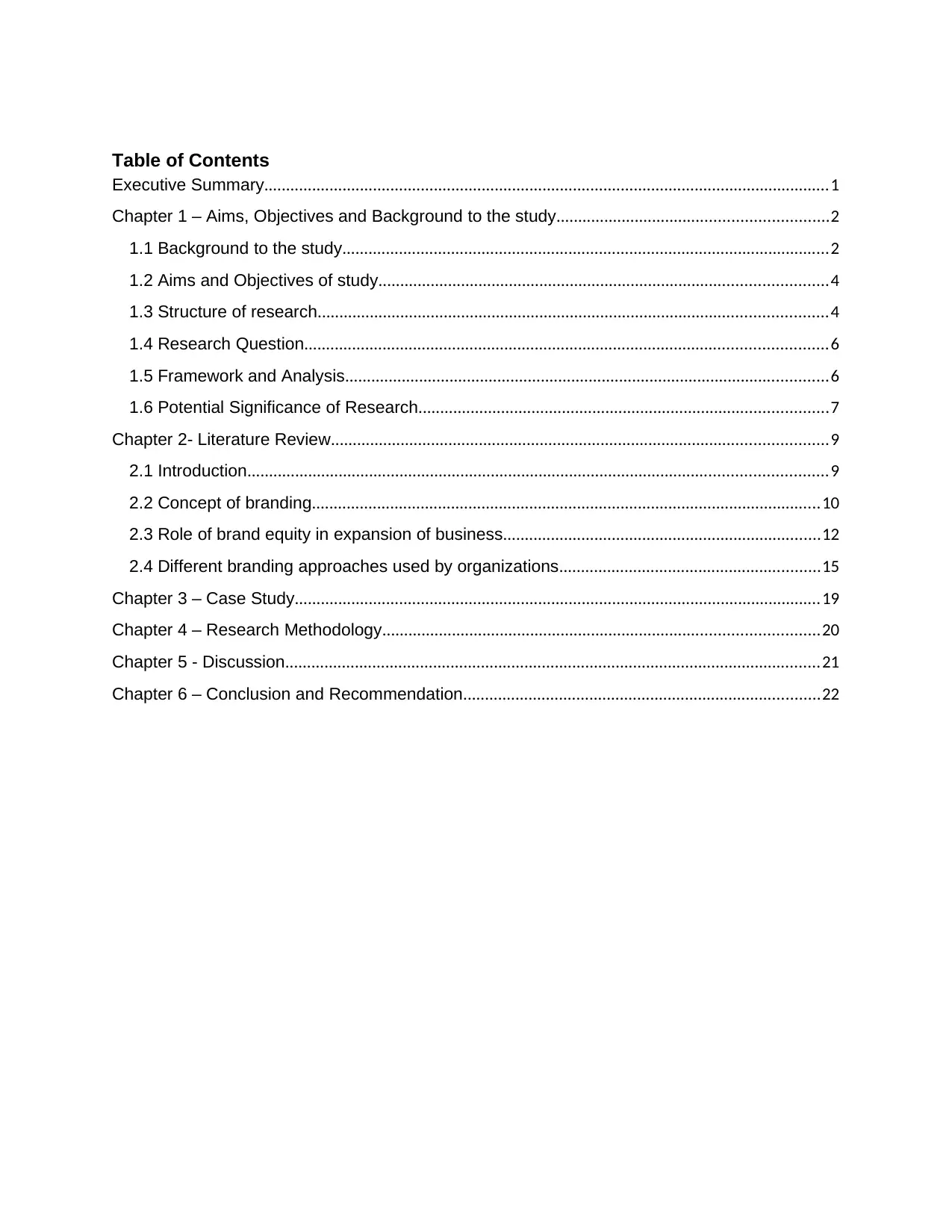
Table of Contents
Executive Summary..................................................................................................................................1
Chapter 1 – Aims, Objectives and Background to the study..............................................................2
1.1 Background to the study................................................................................................................2
1.2 Aims and Objectives of study.......................................................................................................4
1.3 Structure of research.....................................................................................................................4
1.4 Research Question........................................................................................................................6
1.5 Framework and Analysis...............................................................................................................6
1.6 Potential Significance of Research..............................................................................................7
Chapter 2- Literature Review..................................................................................................................9
2.1 Introduction.....................................................................................................................................9
2.2 Concept of branding.....................................................................................................................10
2.3 Role of brand equity in expansion of business.........................................................................12
2.4 Different branding approaches used by organizations............................................................15
Chapter 3 – Case Study.........................................................................................................................19
Chapter 4 – Research Methodology....................................................................................................20
Chapter 5 - Discussion...........................................................................................................................21
Chapter 6 – Conclusion and Recommendation..................................................................................22
Executive Summary..................................................................................................................................1
Chapter 1 – Aims, Objectives and Background to the study..............................................................2
1.1 Background to the study................................................................................................................2
1.2 Aims and Objectives of study.......................................................................................................4
1.3 Structure of research.....................................................................................................................4
1.4 Research Question........................................................................................................................6
1.5 Framework and Analysis...............................................................................................................6
1.6 Potential Significance of Research..............................................................................................7
Chapter 2- Literature Review..................................................................................................................9
2.1 Introduction.....................................................................................................................................9
2.2 Concept of branding.....................................................................................................................10
2.3 Role of brand equity in expansion of business.........................................................................12
2.4 Different branding approaches used by organizations............................................................15
Chapter 3 – Case Study.........................................................................................................................19
Chapter 4 – Research Methodology....................................................................................................20
Chapter 5 - Discussion...........................................................................................................................21
Chapter 6 – Conclusion and Recommendation..................................................................................22

Executive Summary
1
1
⊘ This is a preview!⊘
Do you want full access?
Subscribe today to unlock all pages.

Trusted by 1+ million students worldwide
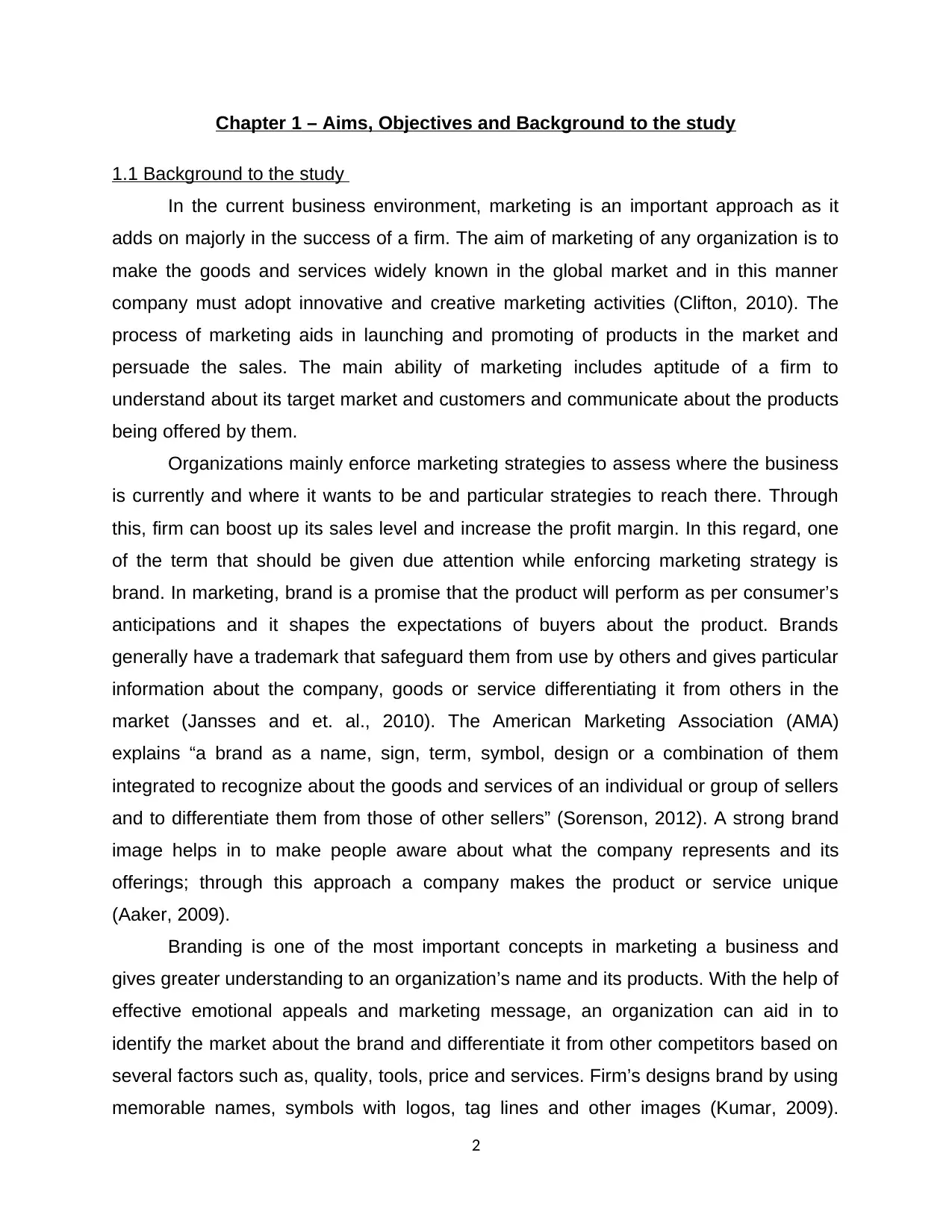
Chapter 1 – Aims, Objectives and Background to the study
1.1 Background to the study
In the current business environment, marketing is an important approach as it
adds on majorly in the success of a firm. The aim of marketing of any organization is to
make the goods and services widely known in the global market and in this manner
company must adopt innovative and creative marketing activities (Clifton, 2010). The
process of marketing aids in launching and promoting of products in the market and
persuade the sales. The main ability of marketing includes aptitude of a firm to
understand about its target market and customers and communicate about the products
being offered by them.
Organizations mainly enforce marketing strategies to assess where the business
is currently and where it wants to be and particular strategies to reach there. Through
this, firm can boost up its sales level and increase the profit margin. In this regard, one
of the term that should be given due attention while enforcing marketing strategy is
brand. In marketing, brand is a promise that the product will perform as per consumer’s
anticipations and it shapes the expectations of buyers about the product. Brands
generally have a trademark that safeguard them from use by others and gives particular
information about the company, goods or service differentiating it from others in the
market (Jansses and et. al., 2010). The American Marketing Association (AMA)
explains “a brand as a name, sign, term, symbol, design or a combination of them
integrated to recognize about the goods and services of an individual or group of sellers
and to differentiate them from those of other sellers” (Sorenson, 2012). A strong brand
image helps in to make people aware about what the company represents and its
offerings; through this approach a company makes the product or service unique
(Aaker, 2009).
Branding is one of the most important concepts in marketing a business and
gives greater understanding to an organization’s name and its products. With the help of
effective emotional appeals and marketing message, an organization can aid in to
identify the market about the brand and differentiate it from other competitors based on
several factors such as, quality, tools, price and services. Firm’s designs brand by using
memorable names, symbols with logos, tag lines and other images (Kumar, 2009).
2
1.1 Background to the study
In the current business environment, marketing is an important approach as it
adds on majorly in the success of a firm. The aim of marketing of any organization is to
make the goods and services widely known in the global market and in this manner
company must adopt innovative and creative marketing activities (Clifton, 2010). The
process of marketing aids in launching and promoting of products in the market and
persuade the sales. The main ability of marketing includes aptitude of a firm to
understand about its target market and customers and communicate about the products
being offered by them.
Organizations mainly enforce marketing strategies to assess where the business
is currently and where it wants to be and particular strategies to reach there. Through
this, firm can boost up its sales level and increase the profit margin. In this regard, one
of the term that should be given due attention while enforcing marketing strategy is
brand. In marketing, brand is a promise that the product will perform as per consumer’s
anticipations and it shapes the expectations of buyers about the product. Brands
generally have a trademark that safeguard them from use by others and gives particular
information about the company, goods or service differentiating it from others in the
market (Jansses and et. al., 2010). The American Marketing Association (AMA)
explains “a brand as a name, sign, term, symbol, design or a combination of them
integrated to recognize about the goods and services of an individual or group of sellers
and to differentiate them from those of other sellers” (Sorenson, 2012). A strong brand
image helps in to make people aware about what the company represents and its
offerings; through this approach a company makes the product or service unique
(Aaker, 2009).
Branding is one of the most important concepts in marketing a business and
gives greater understanding to an organization’s name and its products. With the help of
effective emotional appeals and marketing message, an organization can aid in to
identify the market about the brand and differentiate it from other competitors based on
several factors such as, quality, tools, price and services. Firm’s designs brand by using
memorable names, symbols with logos, tag lines and other images (Kumar, 2009).
2
Paraphrase This Document
Need a fresh take? Get an instant paraphrase of this document with our AI Paraphraser
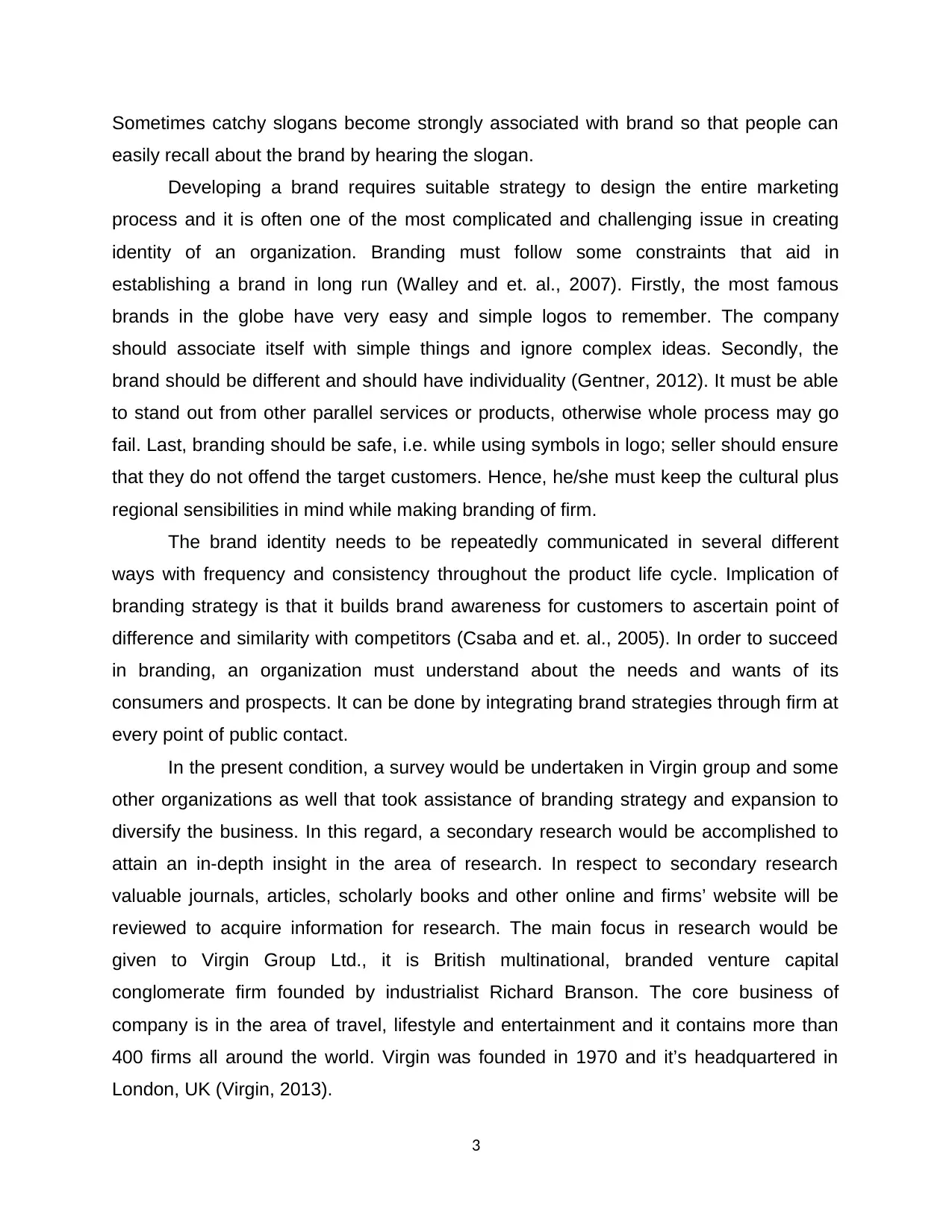
Sometimes catchy slogans become strongly associated with brand so that people can
easily recall about the brand by hearing the slogan.
Developing a brand requires suitable strategy to design the entire marketing
process and it is often one of the most complicated and challenging issue in creating
identity of an organization. Branding must follow some constraints that aid in
establishing a brand in long run (Walley and et. al., 2007). Firstly, the most famous
brands in the globe have very easy and simple logos to remember. The company
should associate itself with simple things and ignore complex ideas. Secondly, the
brand should be different and should have individuality (Gentner, 2012). It must be able
to stand out from other parallel services or products, otherwise whole process may go
fail. Last, branding should be safe, i.e. while using symbols in logo; seller should ensure
that they do not offend the target customers. Hence, he/she must keep the cultural plus
regional sensibilities in mind while making branding of firm.
The brand identity needs to be repeatedly communicated in several different
ways with frequency and consistency throughout the product life cycle. Implication of
branding strategy is that it builds brand awareness for customers to ascertain point of
difference and similarity with competitors (Csaba and et. al., 2005). In order to succeed
in branding, an organization must understand about the needs and wants of its
consumers and prospects. It can be done by integrating brand strategies through firm at
every point of public contact.
In the present condition, a survey would be undertaken in Virgin group and some
other organizations as well that took assistance of branding strategy and expansion to
diversify the business. In this regard, a secondary research would be accomplished to
attain an in-depth insight in the area of research. In respect to secondary research
valuable journals, articles, scholarly books and other online and firms’ website will be
reviewed to acquire information for research. The main focus in research would be
given to Virgin Group Ltd., it is British multinational, branded venture capital
conglomerate firm founded by industrialist Richard Branson. The core business of
company is in the area of travel, lifestyle and entertainment and it contains more than
400 firms all around the world. Virgin was founded in 1970 and it’s headquartered in
London, UK (Virgin, 2013).
3
easily recall about the brand by hearing the slogan.
Developing a brand requires suitable strategy to design the entire marketing
process and it is often one of the most complicated and challenging issue in creating
identity of an organization. Branding must follow some constraints that aid in
establishing a brand in long run (Walley and et. al., 2007). Firstly, the most famous
brands in the globe have very easy and simple logos to remember. The company
should associate itself with simple things and ignore complex ideas. Secondly, the
brand should be different and should have individuality (Gentner, 2012). It must be able
to stand out from other parallel services or products, otherwise whole process may go
fail. Last, branding should be safe, i.e. while using symbols in logo; seller should ensure
that they do not offend the target customers. Hence, he/she must keep the cultural plus
regional sensibilities in mind while making branding of firm.
The brand identity needs to be repeatedly communicated in several different
ways with frequency and consistency throughout the product life cycle. Implication of
branding strategy is that it builds brand awareness for customers to ascertain point of
difference and similarity with competitors (Csaba and et. al., 2005). In order to succeed
in branding, an organization must understand about the needs and wants of its
consumers and prospects. It can be done by integrating brand strategies through firm at
every point of public contact.
In the present condition, a survey would be undertaken in Virgin group and some
other organizations as well that took assistance of branding strategy and expansion to
diversify the business. In this regard, a secondary research would be accomplished to
attain an in-depth insight in the area of research. In respect to secondary research
valuable journals, articles, scholarly books and other online and firms’ website will be
reviewed to acquire information for research. The main focus in research would be
given to Virgin Group Ltd., it is British multinational, branded venture capital
conglomerate firm founded by industrialist Richard Branson. The core business of
company is in the area of travel, lifestyle and entertainment and it contains more than
400 firms all around the world. Virgin was founded in 1970 and it’s headquartered in
London, UK (Virgin, 2013).
3
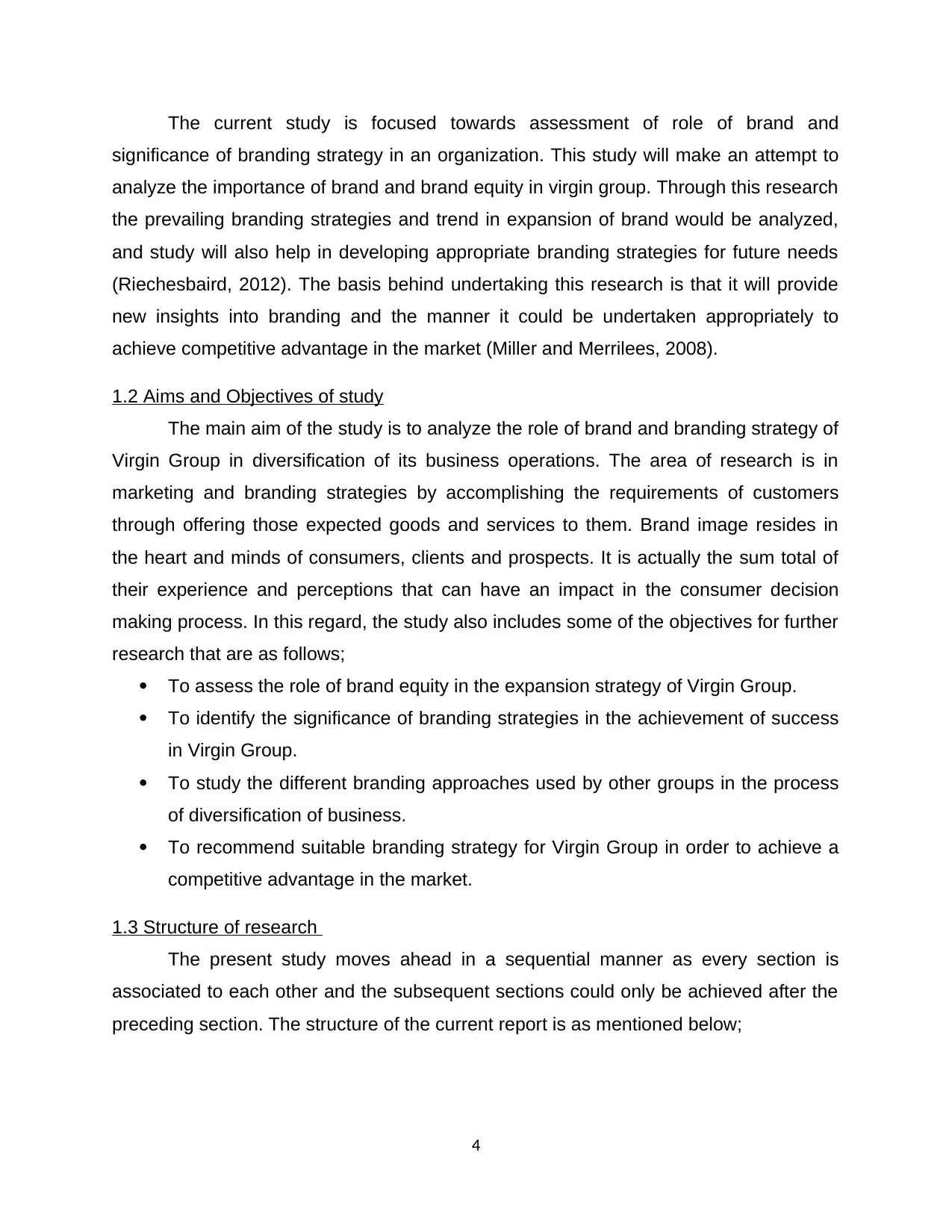
The current study is focused towards assessment of role of brand and
significance of branding strategy in an organization. This study will make an attempt to
analyze the importance of brand and brand equity in virgin group. Through this research
the prevailing branding strategies and trend in expansion of brand would be analyzed,
and study will also help in developing appropriate branding strategies for future needs
(Riechesbaird, 2012). The basis behind undertaking this research is that it will provide
new insights into branding and the manner it could be undertaken appropriately to
achieve competitive advantage in the market (Miller and Merrilees, 2008).
1.2 Aims and Objectives of study
The main aim of the study is to analyze the role of brand and branding strategy of
Virgin Group in diversification of its business operations. The area of research is in
marketing and branding strategies by accomplishing the requirements of customers
through offering those expected goods and services to them. Brand image resides in
the heart and minds of consumers, clients and prospects. It is actually the sum total of
their experience and perceptions that can have an impact in the consumer decision
making process. In this regard, the study also includes some of the objectives for further
research that are as follows;
To assess the role of brand equity in the expansion strategy of Virgin Group.
To identify the significance of branding strategies in the achievement of success
in Virgin Group.
To study the different branding approaches used by other groups in the process
of diversification of business.
To recommend suitable branding strategy for Virgin Group in order to achieve a
competitive advantage in the market.
1.3 Structure of research
The present study moves ahead in a sequential manner as every section is
associated to each other and the subsequent sections could only be achieved after the
preceding section. The structure of the current report is as mentioned below;
4
significance of branding strategy in an organization. This study will make an attempt to
analyze the importance of brand and brand equity in virgin group. Through this research
the prevailing branding strategies and trend in expansion of brand would be analyzed,
and study will also help in developing appropriate branding strategies for future needs
(Riechesbaird, 2012). The basis behind undertaking this research is that it will provide
new insights into branding and the manner it could be undertaken appropriately to
achieve competitive advantage in the market (Miller and Merrilees, 2008).
1.2 Aims and Objectives of study
The main aim of the study is to analyze the role of brand and branding strategy of
Virgin Group in diversification of its business operations. The area of research is in
marketing and branding strategies by accomplishing the requirements of customers
through offering those expected goods and services to them. Brand image resides in
the heart and minds of consumers, clients and prospects. It is actually the sum total of
their experience and perceptions that can have an impact in the consumer decision
making process. In this regard, the study also includes some of the objectives for further
research that are as follows;
To assess the role of brand equity in the expansion strategy of Virgin Group.
To identify the significance of branding strategies in the achievement of success
in Virgin Group.
To study the different branding approaches used by other groups in the process
of diversification of business.
To recommend suitable branding strategy for Virgin Group in order to achieve a
competitive advantage in the market.
1.3 Structure of research
The present study moves ahead in a sequential manner as every section is
associated to each other and the subsequent sections could only be achieved after the
preceding section. The structure of the current report is as mentioned below;
4
⊘ This is a preview!⊘
Do you want full access?
Subscribe today to unlock all pages.

Trusted by 1+ million students worldwide
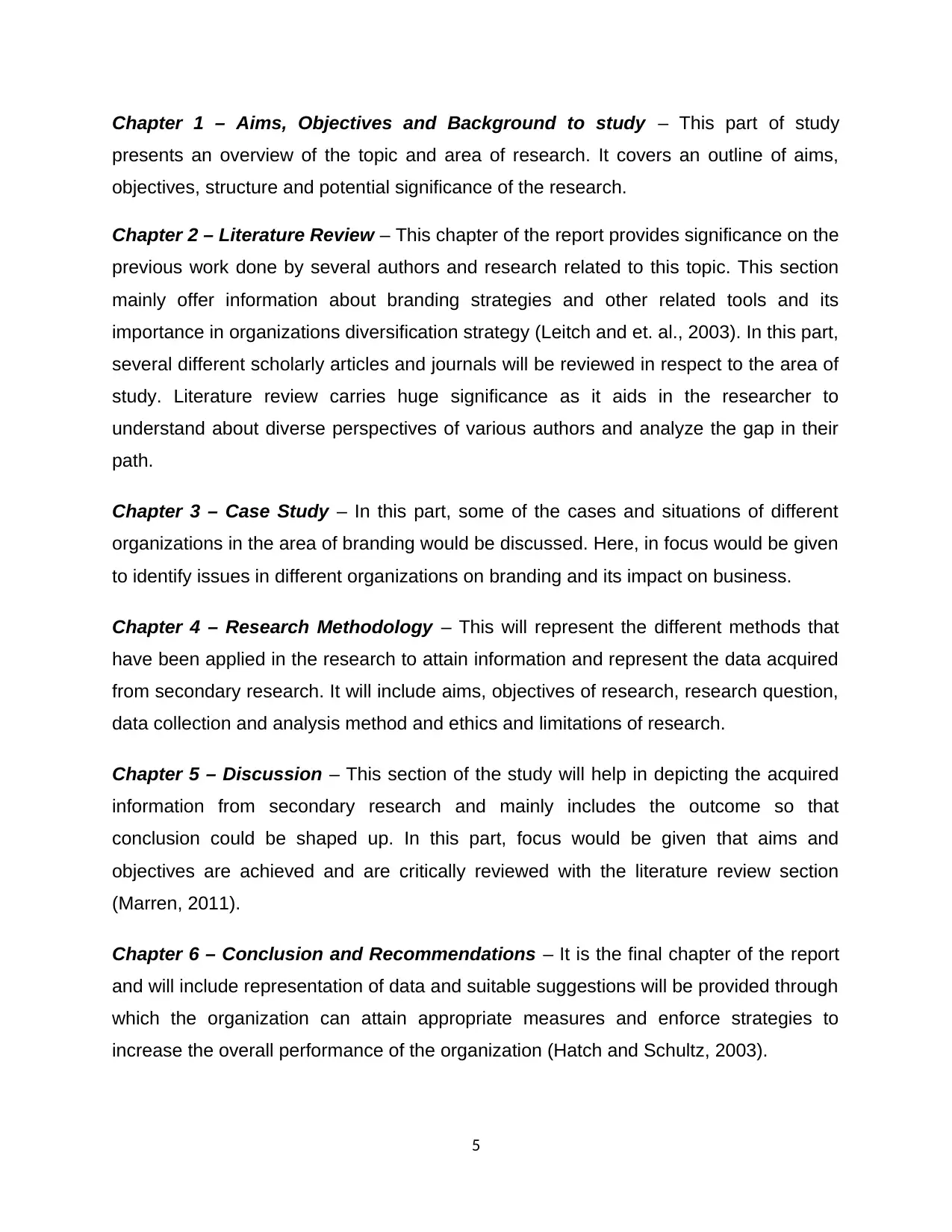
Chapter 1 – Aims, Objectives and Background to study – This part of study
presents an overview of the topic and area of research. It covers an outline of aims,
objectives, structure and potential significance of the research.
Chapter 2 – Literature Review – This chapter of the report provides significance on the
previous work done by several authors and research related to this topic. This section
mainly offer information about branding strategies and other related tools and its
importance in organizations diversification strategy (Leitch and et. al., 2003). In this part,
several different scholarly articles and journals will be reviewed in respect to the area of
study. Literature review carries huge significance as it aids in the researcher to
understand about diverse perspectives of various authors and analyze the gap in their
path.
Chapter 3 – Case Study – In this part, some of the cases and situations of different
organizations in the area of branding would be discussed. Here, in focus would be given
to identify issues in different organizations on branding and its impact on business.
Chapter 4 – Research Methodology – This will represent the different methods that
have been applied in the research to attain information and represent the data acquired
from secondary research. It will include aims, objectives of research, research question,
data collection and analysis method and ethics and limitations of research.
Chapter 5 – Discussion – This section of the study will help in depicting the acquired
information from secondary research and mainly includes the outcome so that
conclusion could be shaped up. In this part, focus would be given that aims and
objectives are achieved and are critically reviewed with the literature review section
(Marren, 2011).
Chapter 6 – Conclusion and Recommendations – It is the final chapter of the report
and will include representation of data and suitable suggestions will be provided through
which the organization can attain appropriate measures and enforce strategies to
increase the overall performance of the organization (Hatch and Schultz, 2003).
5
presents an overview of the topic and area of research. It covers an outline of aims,
objectives, structure and potential significance of the research.
Chapter 2 – Literature Review – This chapter of the report provides significance on the
previous work done by several authors and research related to this topic. This section
mainly offer information about branding strategies and other related tools and its
importance in organizations diversification strategy (Leitch and et. al., 2003). In this part,
several different scholarly articles and journals will be reviewed in respect to the area of
study. Literature review carries huge significance as it aids in the researcher to
understand about diverse perspectives of various authors and analyze the gap in their
path.
Chapter 3 – Case Study – In this part, some of the cases and situations of different
organizations in the area of branding would be discussed. Here, in focus would be given
to identify issues in different organizations on branding and its impact on business.
Chapter 4 – Research Methodology – This will represent the different methods that
have been applied in the research to attain information and represent the data acquired
from secondary research. It will include aims, objectives of research, research question,
data collection and analysis method and ethics and limitations of research.
Chapter 5 – Discussion – This section of the study will help in depicting the acquired
information from secondary research and mainly includes the outcome so that
conclusion could be shaped up. In this part, focus would be given that aims and
objectives are achieved and are critically reviewed with the literature review section
(Marren, 2011).
Chapter 6 – Conclusion and Recommendations – It is the final chapter of the report
and will include representation of data and suitable suggestions will be provided through
which the organization can attain appropriate measures and enforce strategies to
increase the overall performance of the organization (Hatch and Schultz, 2003).
5
Paraphrase This Document
Need a fresh take? Get an instant paraphrase of this document with our AI Paraphraser
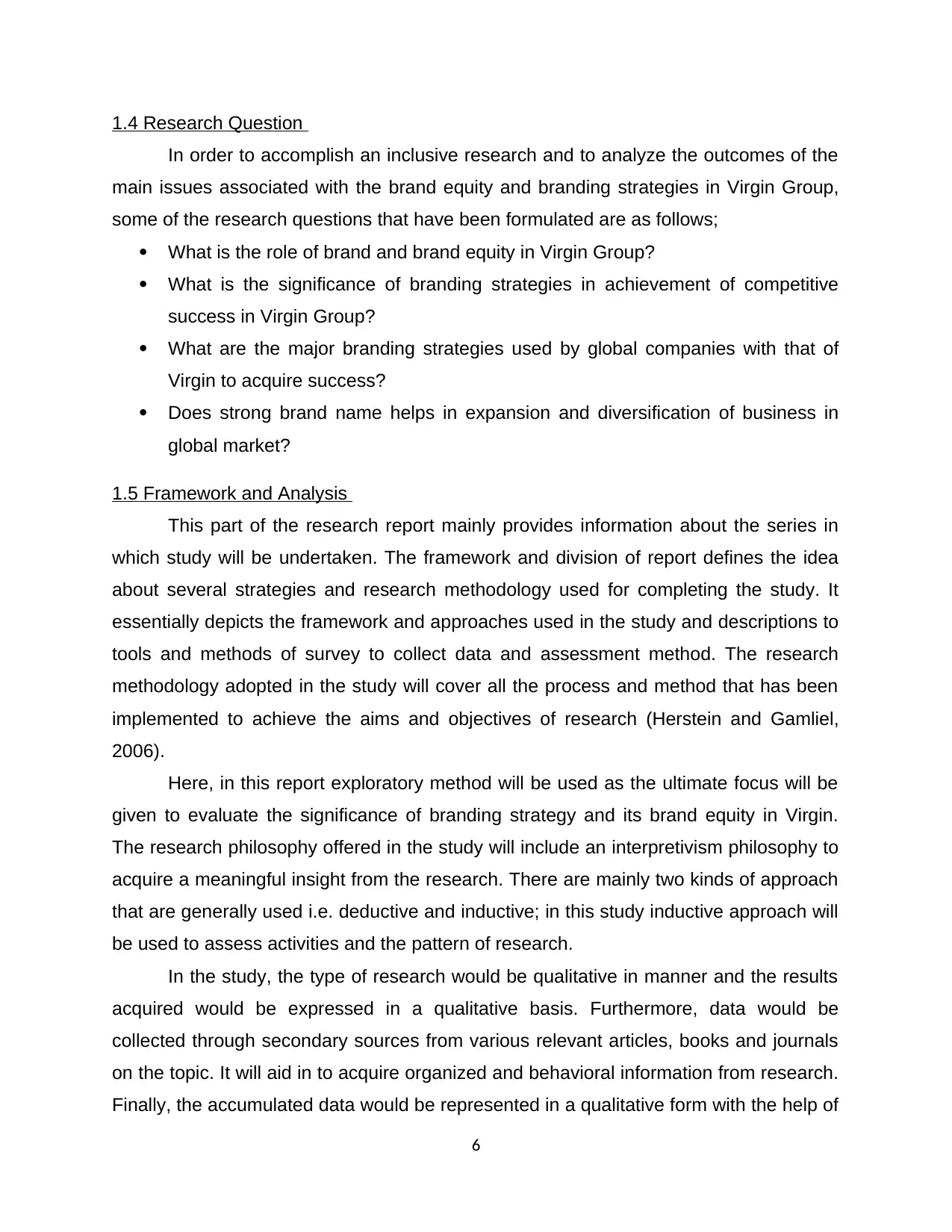
1.4 Research Question
In order to accomplish an inclusive research and to analyze the outcomes of the
main issues associated with the brand equity and branding strategies in Virgin Group,
some of the research questions that have been formulated are as follows;
What is the role of brand and brand equity in Virgin Group?
What is the significance of branding strategies in achievement of competitive
success in Virgin Group?
What are the major branding strategies used by global companies with that of
Virgin to acquire success?
Does strong brand name helps in expansion and diversification of business in
global market?
1.5 Framework and Analysis
This part of the research report mainly provides information about the series in
which study will be undertaken. The framework and division of report defines the idea
about several strategies and research methodology used for completing the study. It
essentially depicts the framework and approaches used in the study and descriptions to
tools and methods of survey to collect data and assessment method. The research
methodology adopted in the study will cover all the process and method that has been
implemented to achieve the aims and objectives of research (Herstein and Gamliel,
2006).
Here, in this report exploratory method will be used as the ultimate focus will be
given to evaluate the significance of branding strategy and its brand equity in Virgin.
The research philosophy offered in the study will include an interpretivism philosophy to
acquire a meaningful insight from the research. There are mainly two kinds of approach
that are generally used i.e. deductive and inductive; in this study inductive approach will
be used to assess activities and the pattern of research.
In the study, the type of research would be qualitative in manner and the results
acquired would be expressed in a qualitative basis. Furthermore, data would be
collected through secondary sources from various relevant articles, books and journals
on the topic. It will aid in to acquire organized and behavioral information from research.
Finally, the accumulated data would be represented in a qualitative form with the help of
6
In order to accomplish an inclusive research and to analyze the outcomes of the
main issues associated with the brand equity and branding strategies in Virgin Group,
some of the research questions that have been formulated are as follows;
What is the role of brand and brand equity in Virgin Group?
What is the significance of branding strategies in achievement of competitive
success in Virgin Group?
What are the major branding strategies used by global companies with that of
Virgin to acquire success?
Does strong brand name helps in expansion and diversification of business in
global market?
1.5 Framework and Analysis
This part of the research report mainly provides information about the series in
which study will be undertaken. The framework and division of report defines the idea
about several strategies and research methodology used for completing the study. It
essentially depicts the framework and approaches used in the study and descriptions to
tools and methods of survey to collect data and assessment method. The research
methodology adopted in the study will cover all the process and method that has been
implemented to achieve the aims and objectives of research (Herstein and Gamliel,
2006).
Here, in this report exploratory method will be used as the ultimate focus will be
given to evaluate the significance of branding strategy and its brand equity in Virgin.
The research philosophy offered in the study will include an interpretivism philosophy to
acquire a meaningful insight from the research. There are mainly two kinds of approach
that are generally used i.e. deductive and inductive; in this study inductive approach will
be used to assess activities and the pattern of research.
In the study, the type of research would be qualitative in manner and the results
acquired would be expressed in a qualitative basis. Furthermore, data would be
collected through secondary sources from various relevant articles, books and journals
on the topic. It will aid in to acquire organized and behavioral information from research.
Finally, the accumulated data would be represented in a qualitative form with the help of
6
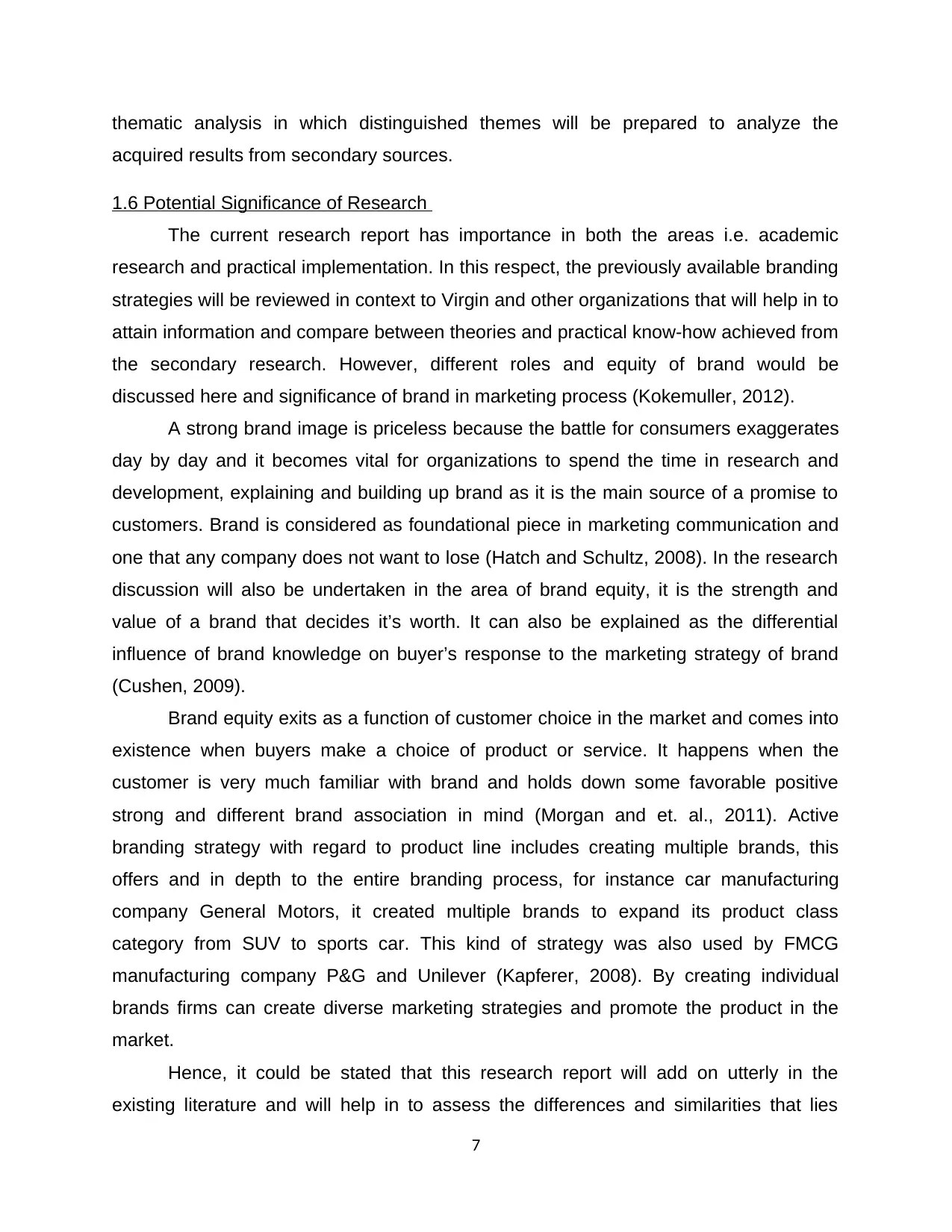
thematic analysis in which distinguished themes will be prepared to analyze the
acquired results from secondary sources.
1.6 Potential Significance of Research
The current research report has importance in both the areas i.e. academic
research and practical implementation. In this respect, the previously available branding
strategies will be reviewed in context to Virgin and other organizations that will help in to
attain information and compare between theories and practical know-how achieved from
the secondary research. However, different roles and equity of brand would be
discussed here and significance of brand in marketing process (Kokemuller, 2012).
A strong brand image is priceless because the battle for consumers exaggerates
day by day and it becomes vital for organizations to spend the time in research and
development, explaining and building up brand as it is the main source of a promise to
customers. Brand is considered as foundational piece in marketing communication and
one that any company does not want to lose (Hatch and Schultz, 2008). In the research
discussion will also be undertaken in the area of brand equity, it is the strength and
value of a brand that decides it’s worth. It can also be explained as the differential
influence of brand knowledge on buyer’s response to the marketing strategy of brand
(Cushen, 2009).
Brand equity exits as a function of customer choice in the market and comes into
existence when buyers make a choice of product or service. It happens when the
customer is very much familiar with brand and holds down some favorable positive
strong and different brand association in mind (Morgan and et. al., 2011). Active
branding strategy with regard to product line includes creating multiple brands, this
offers and in depth to the entire branding process, for instance car manufacturing
company General Motors, it created multiple brands to expand its product class
category from SUV to sports car. This kind of strategy was also used by FMCG
manufacturing company P&G and Unilever (Kapferer, 2008). By creating individual
brands firms can create diverse marketing strategies and promote the product in the
market.
Hence, it could be stated that this research report will add on utterly in the
existing literature and will help in to assess the differences and similarities that lies
7
acquired results from secondary sources.
1.6 Potential Significance of Research
The current research report has importance in both the areas i.e. academic
research and practical implementation. In this respect, the previously available branding
strategies will be reviewed in context to Virgin and other organizations that will help in to
attain information and compare between theories and practical know-how achieved from
the secondary research. However, different roles and equity of brand would be
discussed here and significance of brand in marketing process (Kokemuller, 2012).
A strong brand image is priceless because the battle for consumers exaggerates
day by day and it becomes vital for organizations to spend the time in research and
development, explaining and building up brand as it is the main source of a promise to
customers. Brand is considered as foundational piece in marketing communication and
one that any company does not want to lose (Hatch and Schultz, 2008). In the research
discussion will also be undertaken in the area of brand equity, it is the strength and
value of a brand that decides it’s worth. It can also be explained as the differential
influence of brand knowledge on buyer’s response to the marketing strategy of brand
(Cushen, 2009).
Brand equity exits as a function of customer choice in the market and comes into
existence when buyers make a choice of product or service. It happens when the
customer is very much familiar with brand and holds down some favorable positive
strong and different brand association in mind (Morgan and et. al., 2011). Active
branding strategy with regard to product line includes creating multiple brands, this
offers and in depth to the entire branding process, for instance car manufacturing
company General Motors, it created multiple brands to expand its product class
category from SUV to sports car. This kind of strategy was also used by FMCG
manufacturing company P&G and Unilever (Kapferer, 2008). By creating individual
brands firms can create diverse marketing strategies and promote the product in the
market.
Hence, it could be stated that this research report will add on utterly in the
existing literature and will help in to assess the differences and similarities that lies
7
⊘ This is a preview!⊘
Do you want full access?
Subscribe today to unlock all pages.

Trusted by 1+ million students worldwide
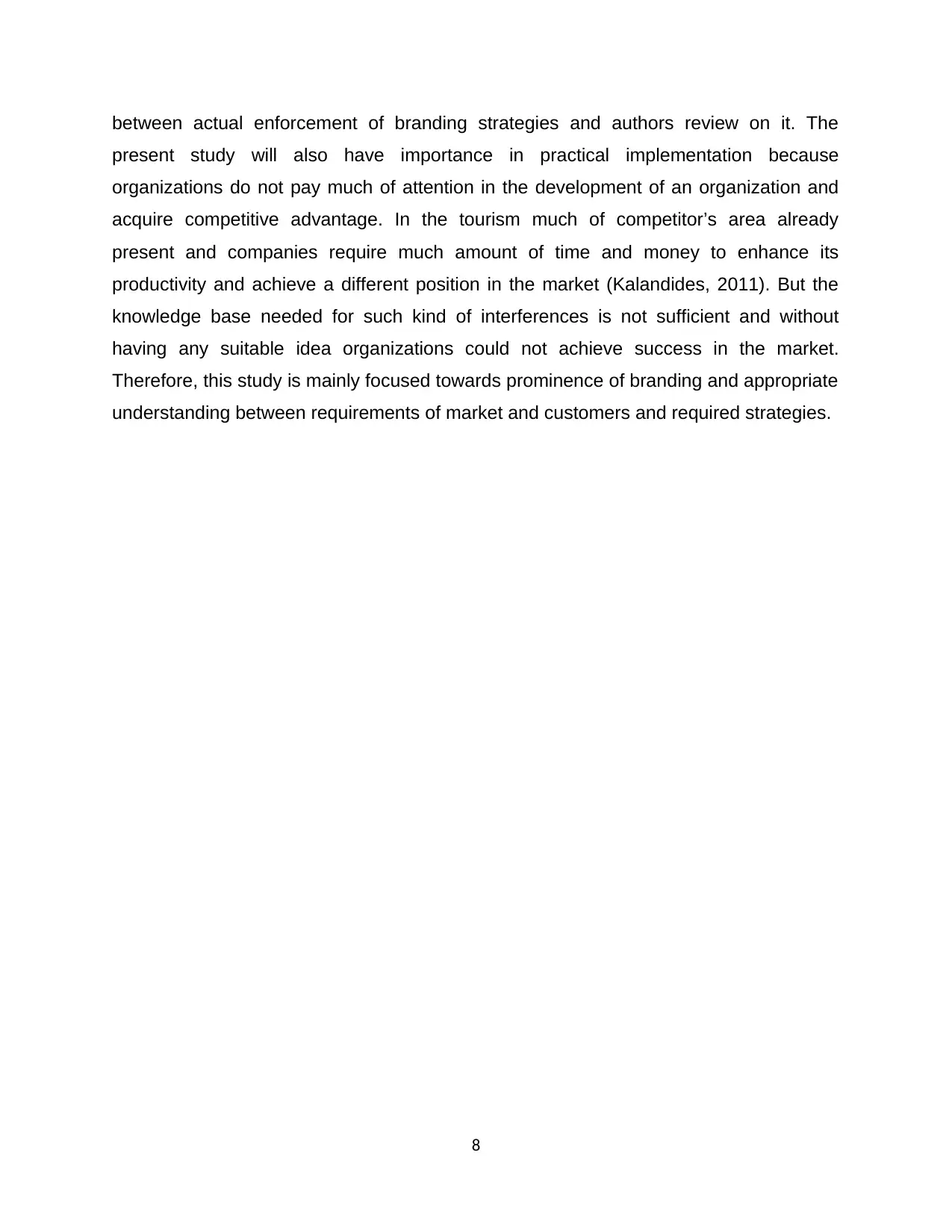
between actual enforcement of branding strategies and authors review on it. The
present study will also have importance in practical implementation because
organizations do not pay much of attention in the development of an organization and
acquire competitive advantage. In the tourism much of competitor’s area already
present and companies require much amount of time and money to enhance its
productivity and achieve a different position in the market (Kalandides, 2011). But the
knowledge base needed for such kind of interferences is not sufficient and without
having any suitable idea organizations could not achieve success in the market.
Therefore, this study is mainly focused towards prominence of branding and appropriate
understanding between requirements of market and customers and required strategies.
8
present study will also have importance in practical implementation because
organizations do not pay much of attention in the development of an organization and
acquire competitive advantage. In the tourism much of competitor’s area already
present and companies require much amount of time and money to enhance its
productivity and achieve a different position in the market (Kalandides, 2011). But the
knowledge base needed for such kind of interferences is not sufficient and without
having any suitable idea organizations could not achieve success in the market.
Therefore, this study is mainly focused towards prominence of branding and appropriate
understanding between requirements of market and customers and required strategies.
8
Paraphrase This Document
Need a fresh take? Get an instant paraphrase of this document with our AI Paraphraser
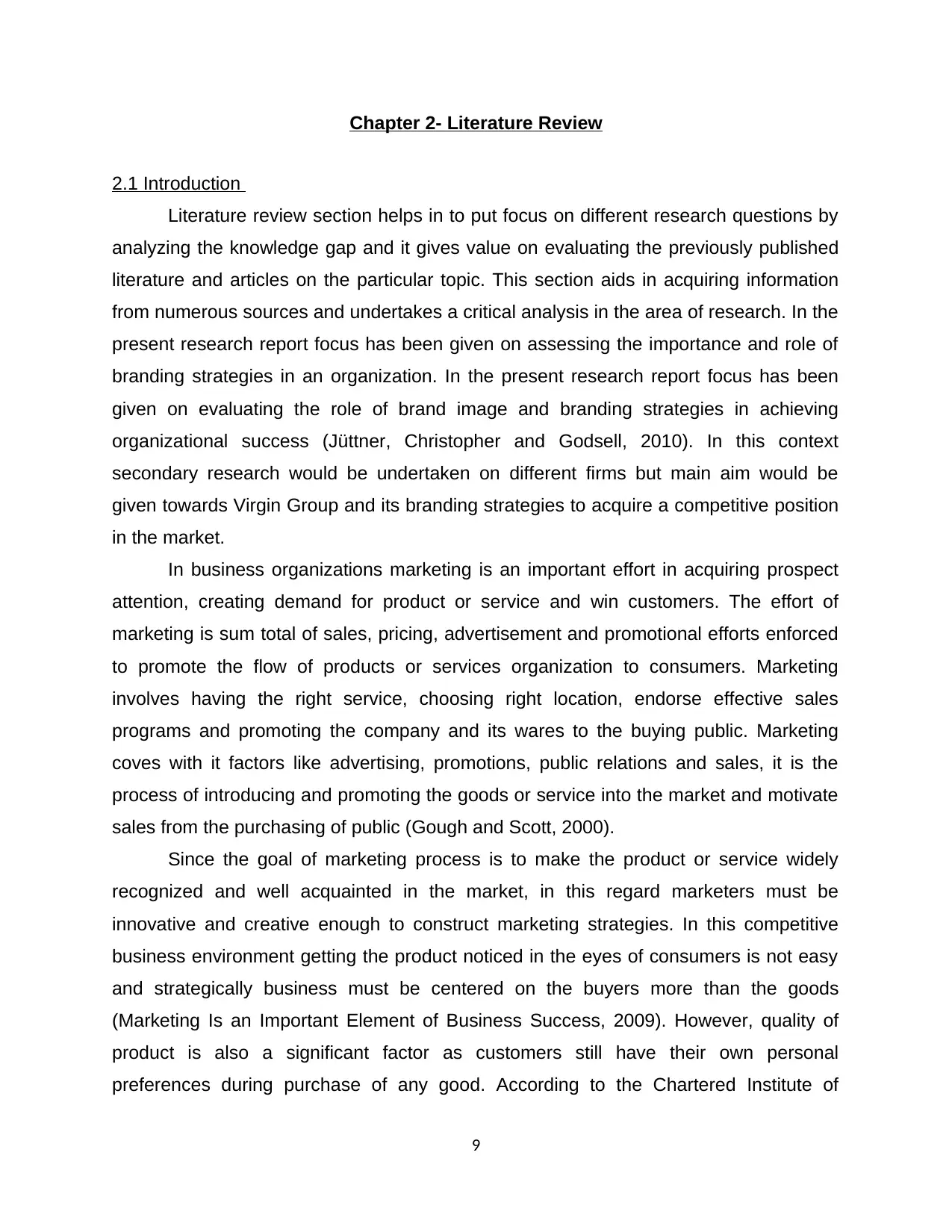
Chapter 2- Literature Review
2.1 Introduction
Literature review section helps in to put focus on different research questions by
analyzing the knowledge gap and it gives value on evaluating the previously published
literature and articles on the particular topic. This section aids in acquiring information
from numerous sources and undertakes a critical analysis in the area of research. In the
present research report focus has been given on assessing the importance and role of
branding strategies in an organization. In the present research report focus has been
given on evaluating the role of brand image and branding strategies in achieving
organizational success (Jüttner, Christopher and Godsell, 2010). In this context
secondary research would be undertaken on different firms but main aim would be
given towards Virgin Group and its branding strategies to acquire a competitive position
in the market.
In business organizations marketing is an important effort in acquiring prospect
attention, creating demand for product or service and win customers. The effort of
marketing is sum total of sales, pricing, advertisement and promotional efforts enforced
to promote the flow of products or services organization to consumers. Marketing
involves having the right service, choosing right location, endorse effective sales
programs and promoting the company and its wares to the buying public. Marketing
coves with it factors like advertising, promotions, public relations and sales, it is the
process of introducing and promoting the goods or service into the market and motivate
sales from the purchasing of public (Gough and Scott, 2000).
Since the goal of marketing process is to make the product or service widely
recognized and well acquainted in the market, in this regard marketers must be
innovative and creative enough to construct marketing strategies. In this competitive
business environment getting the product noticed in the eyes of consumers is not easy
and strategically business must be centered on the buyers more than the goods
(Marketing Is an Important Element of Business Success, 2009). However, quality of
product is also a significant factor as customers still have their own personal
preferences during purchase of any good. According to the Chartered Institute of
9
2.1 Introduction
Literature review section helps in to put focus on different research questions by
analyzing the knowledge gap and it gives value on evaluating the previously published
literature and articles on the particular topic. This section aids in acquiring information
from numerous sources and undertakes a critical analysis in the area of research. In the
present research report focus has been given on assessing the importance and role of
branding strategies in an organization. In the present research report focus has been
given on evaluating the role of brand image and branding strategies in achieving
organizational success (Jüttner, Christopher and Godsell, 2010). In this context
secondary research would be undertaken on different firms but main aim would be
given towards Virgin Group and its branding strategies to acquire a competitive position
in the market.
In business organizations marketing is an important effort in acquiring prospect
attention, creating demand for product or service and win customers. The effort of
marketing is sum total of sales, pricing, advertisement and promotional efforts enforced
to promote the flow of products or services organization to consumers. Marketing
involves having the right service, choosing right location, endorse effective sales
programs and promoting the company and its wares to the buying public. Marketing
coves with it factors like advertising, promotions, public relations and sales, it is the
process of introducing and promoting the goods or service into the market and motivate
sales from the purchasing of public (Gough and Scott, 2000).
Since the goal of marketing process is to make the product or service widely
recognized and well acquainted in the market, in this regard marketers must be
innovative and creative enough to construct marketing strategies. In this competitive
business environment getting the product noticed in the eyes of consumers is not easy
and strategically business must be centered on the buyers more than the goods
(Marketing Is an Important Element of Business Success, 2009). However, quality of
product is also a significant factor as customers still have their own personal
preferences during purchase of any good. According to the Chartered Institute of
9
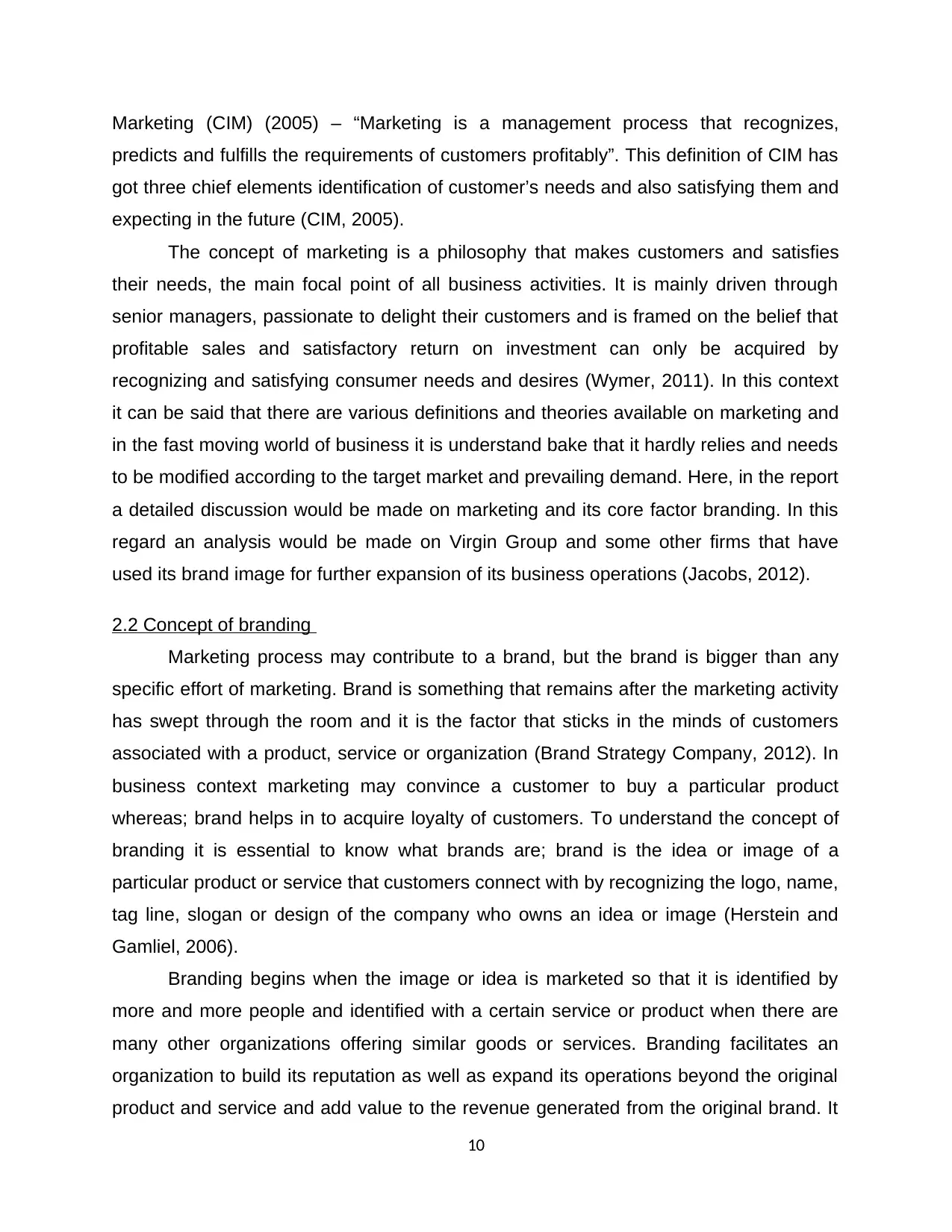
Marketing (CIM) (2005) – “Marketing is a management process that recognizes,
predicts and fulfills the requirements of customers profitably”. This definition of CIM has
got three chief elements identification of customer’s needs and also satisfying them and
expecting in the future (CIM, 2005).
The concept of marketing is a philosophy that makes customers and satisfies
their needs, the main focal point of all business activities. It is mainly driven through
senior managers, passionate to delight their customers and is framed on the belief that
profitable sales and satisfactory return on investment can only be acquired by
recognizing and satisfying consumer needs and desires (Wymer, 2011). In this context
it can be said that there are various definitions and theories available on marketing and
in the fast moving world of business it is understand bake that it hardly relies and needs
to be modified according to the target market and prevailing demand. Here, in the report
a detailed discussion would be made on marketing and its core factor branding. In this
regard an analysis would be made on Virgin Group and some other firms that have
used its brand image for further expansion of its business operations (Jacobs, 2012).
2.2 Concept of branding
Marketing process may contribute to a brand, but the brand is bigger than any
specific effort of marketing. Brand is something that remains after the marketing activity
has swept through the room and it is the factor that sticks in the minds of customers
associated with a product, service or organization (Brand Strategy Company, 2012). In
business context marketing may convince a customer to buy a particular product
whereas; brand helps in to acquire loyalty of customers. To understand the concept of
branding it is essential to know what brands are; brand is the idea or image of a
particular product or service that customers connect with by recognizing the logo, name,
tag line, slogan or design of the company who owns an idea or image (Herstein and
Gamliel, 2006).
Branding begins when the image or idea is marketed so that it is identified by
more and more people and identified with a certain service or product when there are
many other organizations offering similar goods or services. Branding facilitates an
organization to build its reputation as well as expand its operations beyond the original
product and service and add value to the revenue generated from the original brand. It
10
predicts and fulfills the requirements of customers profitably”. This definition of CIM has
got three chief elements identification of customer’s needs and also satisfying them and
expecting in the future (CIM, 2005).
The concept of marketing is a philosophy that makes customers and satisfies
their needs, the main focal point of all business activities. It is mainly driven through
senior managers, passionate to delight their customers and is framed on the belief that
profitable sales and satisfactory return on investment can only be acquired by
recognizing and satisfying consumer needs and desires (Wymer, 2011). In this context
it can be said that there are various definitions and theories available on marketing and
in the fast moving world of business it is understand bake that it hardly relies and needs
to be modified according to the target market and prevailing demand. Here, in the report
a detailed discussion would be made on marketing and its core factor branding. In this
regard an analysis would be made on Virgin Group and some other firms that have
used its brand image for further expansion of its business operations (Jacobs, 2012).
2.2 Concept of branding
Marketing process may contribute to a brand, but the brand is bigger than any
specific effort of marketing. Brand is something that remains after the marketing activity
has swept through the room and it is the factor that sticks in the minds of customers
associated with a product, service or organization (Brand Strategy Company, 2012). In
business context marketing may convince a customer to buy a particular product
whereas; brand helps in to acquire loyalty of customers. To understand the concept of
branding it is essential to know what brands are; brand is the idea or image of a
particular product or service that customers connect with by recognizing the logo, name,
tag line, slogan or design of the company who owns an idea or image (Herstein and
Gamliel, 2006).
Branding begins when the image or idea is marketed so that it is identified by
more and more people and identified with a certain service or product when there are
many other organizations offering similar goods or services. Branding facilitates an
organization to build its reputation as well as expand its operations beyond the original
product and service and add value to the revenue generated from the original brand. It
10
⊘ This is a preview!⊘
Do you want full access?
Subscribe today to unlock all pages.

Trusted by 1+ million students worldwide
1 out of 29
Related Documents
Your All-in-One AI-Powered Toolkit for Academic Success.
+13062052269
info@desklib.com
Available 24*7 on WhatsApp / Email
![[object Object]](/_next/static/media/star-bottom.7253800d.svg)
Unlock your academic potential
Copyright © 2020–2025 A2Z Services. All Rights Reserved. Developed and managed by ZUCOL.





